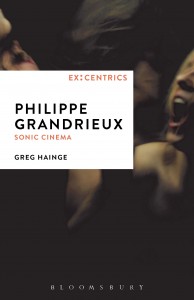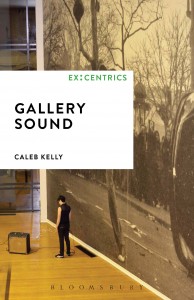ex:centrics
A series of books on contemporary art and music examining people, practices and movements from the space in-between, neither mainstream nor underground.
Lynch and Sound
 Earlier this y ear one of the world’s true ex:centrics, David Lynch, was showcased in a major exhibition at the Gallery of Modern Art, Brisbane. The show, brilliantly curated by Jose da Silva, presented the largest collection of his artworks ever assembled in one place and a complete retrospective of his work for the screen. Given the brief of ex:centrics, Lynch of course cuts an interesting figure, because whilst he is in many ways the very embodiment of an ex:centric, the kind of canonisation that a major international show like this signals throws the whole idea of centre and margins into a state of flux. If previously, especially in musical circles, this kind of recognition may have been figured as indicative of an artist “selling out”, my suspicion is that phenomena such as this speak more now to the ways in which the culture industry is changing.
Earlier this y ear one of the world’s true ex:centrics, David Lynch, was showcased in a major exhibition at the Gallery of Modern Art, Brisbane. The show, brilliantly curated by Jose da Silva, presented the largest collection of his artworks ever assembled in one place and a complete retrospective of his work for the screen. Given the brief of ex:centrics, Lynch of course cuts an interesting figure, because whilst he is in many ways the very embodiment of an ex:centric, the kind of canonisation that a major international show like this signals throws the whole idea of centre and margins into a state of flux. If previously, especially in musical circles, this kind of recognition may have been figured as indicative of an artist “selling out”, my suspicion is that phenomena such as this speak more now to the ways in which the culture industry is changing.
The Spectacle of Listening
By Paul Hegarty
 There’s a lot of listening happening today. A lot of attention paid to hearing, to sound, to openness, to empathic communication, to shared soundworlds. Some of this attention happens in the zone of sound studies, pleased that at least some part of the world around it has finally grasped McLuhan’s sense that the future would be full of sound, and that the acoustic would be the privileged way of imaging space and social interaction. Without wishing to distinguish too much between listening and hearing, can we say that hearing more sound is better? Presumably, as writers never tire of pretending, the ears cannot be closed, so so react passively, even submissively to sound produced by someone else. Acoustic ecology tries to rectify this terrifying presence of McLuhan’s allatonceness, and restore the measure of listening, in place of unwilled hearing.
There’s a lot of listening happening today. A lot of attention paid to hearing, to sound, to openness, to empathic communication, to shared soundworlds. Some of this attention happens in the zone of sound studies, pleased that at least some part of the world around it has finally grasped McLuhan’s sense that the future would be full of sound, and that the acoustic would be the privileged way of imaging space and social interaction. Without wishing to distinguish too much between listening and hearing, can we say that hearing more sound is better? Presumably, as writers never tire of pretending, the ears cannot be closed, so so react passively, even submissively to sound produced by someone else. Acoustic ecology tries to rectify this terrifying presence of McLuhan’s allatonceness, and restore the measure of listening, in place of unwilled hearing.
Coil
 Watch this space for details of a future volume on Coil we are very excited about.
Watch this space for details of a future volume on Coil we are very excited about.
Philippe Grandrieux
 Philippe Grandrieux is one of cinema’s only living true radicals and feted as one of the most innovative and important film makers of his generation. His consistently controversial work remains, however, relatively unknown outside of the international art film festival circuit. In this volume, the first book-length study of the work of Grandrieux in any language, Greg Hainge provides an overview and critical analysis of Grandrieux’s entire career during which he has produced works for television, video installations, photography, performance pieces, documentary films, short films and prize-winning feature films. As well as providing an overview, the book argues that a critical appraisal of his work necessarily leads us to problematize many of the critical orthodoxies that have been formed in recent times, to reject the concept of a haptic cinema and to supplant this instead with the idea of a sonic cinema.
Philippe Grandrieux is one of cinema’s only living true radicals and feted as one of the most innovative and important film makers of his generation. His consistently controversial work remains, however, relatively unknown outside of the international art film festival circuit. In this volume, the first book-length study of the work of Grandrieux in any language, Greg Hainge provides an overview and critical analysis of Grandrieux’s entire career during which he has produced works for television, video installations, photography, performance pieces, documentary films, short films and prize-winning feature films. As well as providing an overview, the book argues that a critical appraisal of his work necessarily leads us to problematize many of the critical orthodoxies that have been formed in recent times, to reject the concept of a haptic cinema and to supplant this instead with the idea of a sonic cinema.
Gallery Sound
 Caleb Kelly’s Gallery Sound argues for the importance of sound within the architecture of the art space. From video art to floor talks, from performance to cash registers, sound fills the exhibition environment. Yet sound is a phenomenon that inevitably confounds boundaries, forever bleeding through walls and encroaching into spaces not its own. This book will listen to the deliberate inclusion of sound within the sound arts, as well as the incidental sounds that while generally unwanted have been mined for creative outputs.
Caleb Kelly’s Gallery Sound argues for the importance of sound within the architecture of the art space. From video art to floor talks, from performance to cash registers, sound fills the exhibition environment. Yet sound is a phenomenon that inevitably confounds boundaries, forever bleeding through walls and encroaching into spaces not its own. This book will listen to the deliberate inclusion of sound within the sound arts, as well as the incidental sounds that while generally unwanted have been mined for creative outputs.